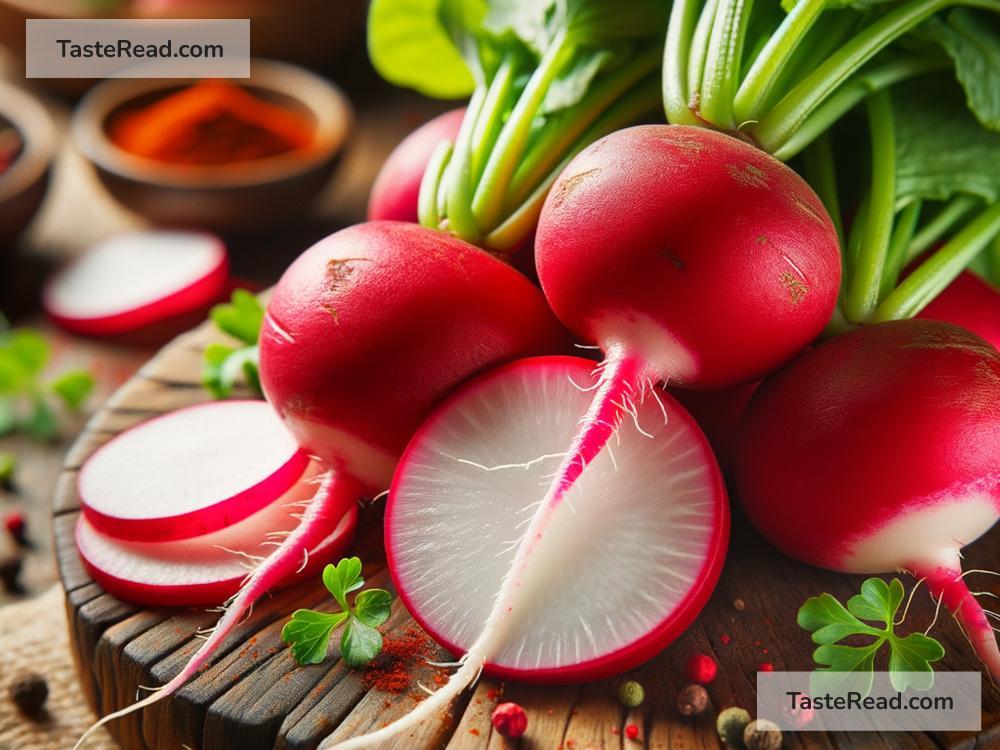What Makes Radishes Taste Peppery?
Radishes are small, crunchy root vegetables that surprise you with their bold, peppery kick. You’ve probably eaten them raw in salads, as a snack, or even pickled. But have you ever wondered where that spicy, tangy taste comes from? In this blog, we’ll explore the science behind the peppery flavor of radishes and uncover the chemical compounds responsible for this unique taste. Don’t worry—we’ll keep the explanation simple!
The Radish’s Tangy Personality
Radishes belong to the mustard family, scientifically known as the Brassicaceae family. This group includes other spicy vegetables like horseradish, mustard greens, arugula, and wasabi. Just like its cousins, the radish packs a punch thanks to a special group of chemical compounds called glucosinolates and their breakdown products, isothiocyanates.
These compounds are the radish’s secret to flavor. When you bite into a radish, the spicy taste is not sitting around waiting for you. Instead, it is created on the spot by a clever chemical reaction.
Where It All Begins: Glucosinolates
Glucosinolates are naturally occurring compounds found in many plants of the mustard family. They play a major role in defending the plant against pests and diseases. Think of them as the radish’s built-in security system.
By themselves, glucosinolates don’t taste peppery or spicy. They’re just sitting quietly inside the radish cells. But when the radish is damaged—say, when you chop it, bite into it, or crush it—a big reaction happens.
The Chemical Reaction: Isothiocyanates
When the radish is cut or chewed, the cells break open and mix glucosinolates with an enzyme called myrosinase. This enzyme acts like a match, lighting the fire that transforms the glucosinolates into spicy compounds known as isothiocyanates.
Isothiocyanates are what give radishes their signature peppery taste. They’re also the reason why mustard, horseradish, and wasabi sting your nose or make your tongue tingle. In radishes, the specific type of isothiocyanate responsible for the flavor is called 4-methylthio-3-butenyl isothiocyanate.
The moment this compound is created, your taste buds pick up its bold profile: spicy, slightly tangy, and a little sharp.
Why Are Some Radishes Spicier Than Others?
If you’ve eaten radishes often, you’ve probably noticed that not all radishes taste the same. Some are mild and mellow, while others feel like they’re breathing fire on your tongue. This variation is caused by several factors:
-
Variety of Radish
Different types of radishes have different amounts of glucosinolates. For example, smaller red radishes tend to be milder, while the large white daikon radishes from Asian cuisine are less peppery. On the other hand, black radishes pack quite a strong kick! -
Growing Conditions
A radish’s environment—its soil, weather, and water—plays a big role in how spicy it becomes. Radishes grown in dry or stressful conditions produce more glucosinolates. They do this as a defense mechanism to stay strong and survive tough environments. As a result, spicier radishes often come from harsher growing conditions. -
Age of the Radish
Young, freshly harvested radishes tend to be sweeter and less spicy, while older radishes develop a stronger flavor with more isothiocyanates. If you prefer a milder taste, choose younger radishes when shopping for produce.
Why Do Radishes Sting Your Nose and Throat?
If radishes are particularly spicy, you might feel a tingling or stinging sensation in your nose and throat as you eat them. That’s because isothiocyanates don’t just affect your taste buds—they can also interact with your nasal passages and mucous membranes.
This happens with other foods like mustard or wasabi as well. The compounds travel up to your nose, creating a sharp sensation that can feel intense but doesn’t last long.
Are Isothiocyanates Healthy?
Yes! Beyond their flavor, isothiocyanates are actually good for your health. Scientists have researched their antioxidant and anti-inflammatory properties, which can help protect your body from certain diseases. They’re also thought to support detoxification processes by helping your body eliminate harmful toxins.
Radishes, along with other Brassicaceae vegetables, are packed with glucosinolates and isothiocyanates, making them not only flavorful but also a great addition to a healthy diet.
How to Enjoy Radishes
If the peppery taste is too strong for you, you can tone it down by cooking radishes. Heat reduces the concentration of isothiocyanates, giving cooked radishes a softer, sweeter flavor. Try roasting them in the oven or tossing them into soups and stews.
On the other hand, if you love the spice, eat radishes raw in salads or as a crunchy snack. Pair them with mild cream-based dips or cheese to balance the spiciness.
Conclusion
Radishes owe their peppery taste to a fascinating chemical reaction that involves glucosinolates and the enzyme myrosinase. When these two meet, they produce isothiocyanates—the compounds responsible for that bold, spicy flavor.
Whether you enjoy radishes for their crunch, their zing, or their health benefits, they’re truly one of nature’s flavorful wonders. Next time you bite into a radish, take a moment to appreciate the chemistry happening right on your taste buds.


